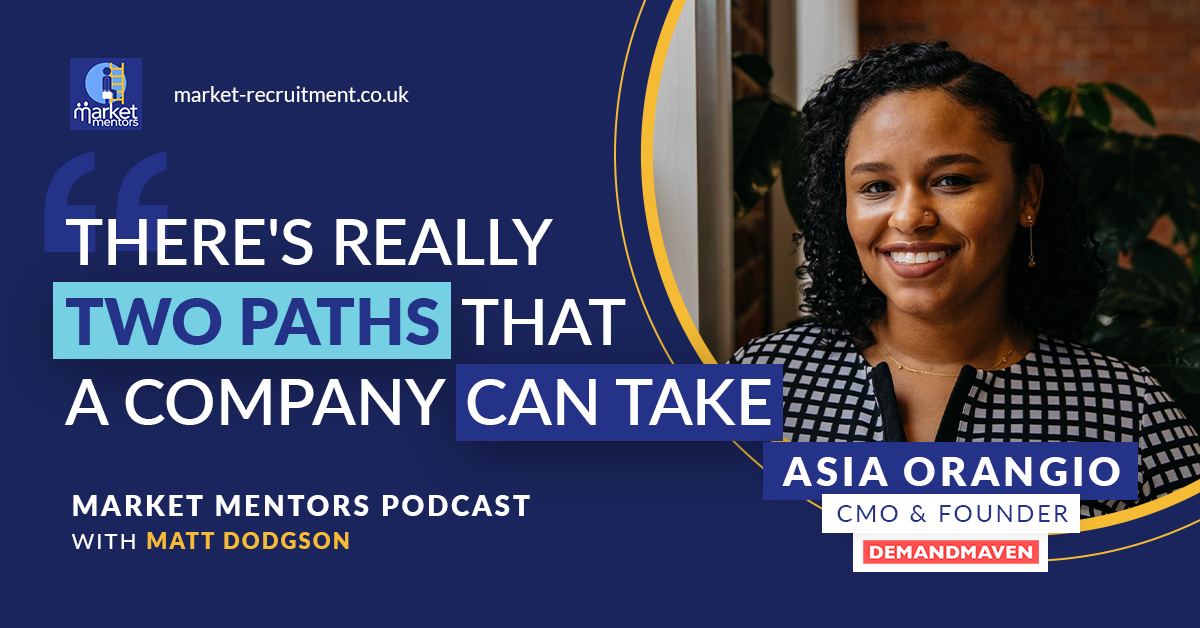
As an early stage B2B tech start-up, getting your first 100 customers is a significant task. Not only is the technology market incredibly competitive these days, but customer acquisition costs are going through the roof. And if that wasn’t enough, at the time of this blog, there’s growing economic uncertainty.
The obvious solution is to hire a demand generation focussed marketer and start to run a wide variety of campaigns. Putting some budget behind things like this will start to get everything moving.
Unfortunately, that doesn’t always set you up for success. And it can often lead to frustrations between the founding team and the marketer(s), which in turn leads to people getting despondent about marketing altogether.
So what’s a better way to get your first 100 customers?
Today I’m joined by Asia Orangia, who talks to me about the proven steps she goes through when working with early stage B2B tech start-ups on customer acquisition.
Who they are: Asia Orangio is CEO & Founder of DemandMaven.
A bit of background: Asia helps SaaS teams and startups reach their growth goals through tried-and-true go-to-market strategy, customer research, positioning and messaging, and growth practices. Asia also served on the board of directors at Moz before it was successfully acquired in 2021. In early 2018, Asia founded DemandMaven — a growth consultancy that helps SaaS, software, and internet-based companies troubleshoot their growth, identify new growth opportunities, and successfully go-to-market. Previously, Asia served in a number of marketing roles, but most notably as head of marketing at Hull where she helped the team 10.5x in growth, and #FlipMyFunnel / Terminus as demand generation manager.
Where you can find Asia:
You can connect with Asia on LinkedIn here.
You can connect with Asia on Twitter here.
Here you’ll find some of the best advice from the podcast that you can easily digest and learn from.
Invariably in most B2B tech start-ups, the founder or founding team are technical in nature. They’ve probably identified the problem and built a product to solve that problem.
As developers at heart, they’re used to quick feedback loops. You write code, deploy code and know whether it works instantaneously.
Unfortunately, start-up marketing doesn’t quite work like that. Asia explains:
“When you get into something like marketing, I like to explain it like long-term code deployments. You’re not necessarily going to know instantaneously or even ever, exactly if and how it works. That’s really scary for a lot of technical founders.
“And yes, of course you want short-term tactics that get you customers, but the reality is that when it comes to marketing, you’re ultimately dealing with people, not code.
“It takes longer for people to make decisions, it takes longer for people to really believe in what you’re building and that it can ultimately help solve their problem. And it just takes longer to actually find you in the first place. So usually impatience is what prevents founders and these early teams from getting their first 100 customers.”
As for marketers, and this will apply to founders too, there’s often a lack of understanding about the customer.
Interactions with customers are too often through support tickets or demo calls. There’s some basic discovery done, but most of the interactions are about the product itself. Yet a clear understanding of your target customer is a fundamental requirement of effective marketing.
Asia explains:
“Teams that really struggle with acquisition, nine times out of 10, it’s because they just don’t understand their customer. They’re trying a whole lot of things that don’t actually match with what the customer experience looks like. And they don’t really understand what’s triggering a customer to consider the solution anyway.”
To understand the customer, Asia recommends asking questions such as:
Too often B2B start-ups start executing marketing campaigns to create demand before they’ve completed the important foundational work.
The problem with running straight into running campaigns is that the success of those can be hit and miss. Most companies in the early stages need to do more work to get to product-market fit, or as close as they can get.
To do that, Asia recommends:
And how do you know when you’ve got true product-market fit?
“You can feel it. It feels like you are in a kayak or a raft raging down a river and everything that you do to try to stop the kayak, it’s not going to stop. That’s product market fit and it’s a great feeling.”
To understand what channels to use to acquire your first 100 customers, all the really hard work will have been done in your customer discovery. During those calls it’s important to ask them about where they hang out, how they consume information and where they go to do that – events, social, communities etc.
But it’s also important to supplement that with your own research through tools like SparkToro, Moz or Ahrefs. Identify who the influencers are in your market, and where they promote and publish their content.
From here you’ll start to get a really good idea of what channels to use. And then you can start to launch some campaigns to generate demand.
Having worked with plenty of B2B tech companies on this, Asia has seen good results following these steps:
Hiring? Market Recruitment is a leading recruitment agency for B2B tech startups. Contact us here to find out more.
Subscribe to our fortnightly newsletter to hear about our latest podcasts, blogs, career advice & jobs.